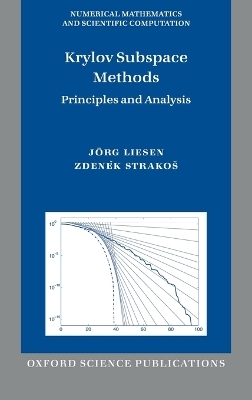
Krylov Subspace Methods
Oxford University Press (Verlag)
978-0-19-965541-0 (ISBN)
The mathematical theory of Krylov subspace methods with a focus on solving systems of linear algebraic equations is given a detailed treatment in this principles-based book. Starting from the idea of projections, Krylov subspace methods are characterised by their orthogonality and minimisation properties. Projections onto highly nonlinear Krylov subspaces can be linked with the underlying problem of moments, and therefore Krylov subspace methods can be viewed as matching moments model reduction. This allows enlightening reformulations of questions from matrix computations into the language of orthogonal polynomials, Gauss-Christoffel quadrature, continued fractions, and, more generally, of Vorobyev's method of moments. Using the concept of cyclic invariant subspaces, conditions are studied that allow the generation of orthogonal Krylov subspace bases via short recurrences. The results motivate the important practical distinction between Hermitian and non-Hermitian problems. Finally, the book thoroughly addresses the computational cost while using Krylov subspace methods. The investigation includes effects of finite precision arithmetic and focuses on the method of conjugate gradients (CG) and generalised minimal residuals (GMRES) as major examples.
There is an emphasis on the way algebraic computations must always be considered in the context of solving real-world problems, where the mathematical modelling, discretisation and computation cannot be separated from each other. The book also underlines the importance of the historical context and demonstrates that knowledge of early developments can play an important role in understanding and resolving very recent computational problems. Many extensive historical notes are included as an inherent part of the text as well as the formulation of some omitted issues and challenges which need to be addressed in future work.
This book is applicable to a wide variety of graduate courses on Krylov subspace methods and related subjects, as well as benefiting those interested in the history of mathematics.
Jörg Liesen is a professor of Numerical Mathematics at the TU Berlin, Germany. He received his Ph.D. in Mathematics from the University of Bielefeld under the supervision of Ludwig Elsner, and the Habilitation in Mathematics at the TU Berlin. During his professional career he spent two years at the University of Illinois at Urbana-Champaign, USA. His research interests in numerical analysis include the convergence and stability analysis of iterative methods, and the theory and computation of matrix functions. He is also interested in the history of mathematics, in particular of linear algebra. He is the recipient of several prizes and awards, including the Householder Award in 1999, the Emmy Noether Fellowship of the DFG, and the Heisenberg Professorship of the DFG. Zdenek Strakos is a professor of Mathematics at the Charles University in Prague, Czech Republic. He received his Ph.D. in Computer Science from the Czechoslovak Academy of Sciences, and D.Sc. in Mathematics from the Academy of Sciences of the Czech Republic. During his professional career he spent one year at IMA, University of Minnesota, and three years at Emory University, Atlanta. He likes to look for interconnections between problems and disciplines and to view particular questions in their wide context. He is an active member of professional committees and boards, such as the Householder Committee, the EMS Applied Mathematics Committee, ERC AdG Evaluation Panel for Computer Science and Informatics etc. In 1994 he was awarded the SIAM Activity Group of Linear Algebra Prize and in 2007 the Annual Prize of the Academy of Sciences of the Czech Republic.
1. Introduction ; 2. Krylov subspace methods ; 3. Matching moments and model reduction view ; 4. Short recurrences for generating orthogonal Krylov subspace bases ; 5. Cost of computations using Krylov subspace methods
| Erscheint lt. Verlag | 6.12.2012 |
|---|---|
| Reihe/Serie | Numerical Mathematics and Scientific Computation |
| Zusatzinfo | 43 b/w line drawings |
| Verlagsort | Oxford |
| Sprache | englisch |
| Maße | 162 x 234 mm |
| Gewicht | 742 g |
| Themenwelt | Mathematik / Informatik ► Mathematik ► Algebra |
| Mathematik / Informatik ► Mathematik ► Angewandte Mathematik | |
| Technik ► Maschinenbau | |
| ISBN-10 | 0-19-965541-3 / 0199655413 |
| ISBN-13 | 978-0-19-965541-0 / 9780199655410 |
| Zustand | Neuware |
| Haben Sie eine Frage zum Produkt? |
aus dem Bereich


